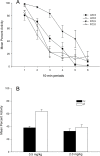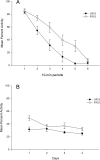Conditioned increase of locomotor activity induced by haloperidol
- PMID: 30281607
- PMCID: PMC6169844
- DOI: 10.1371/journal.pone.0200178
Conditioned increase of locomotor activity induced by haloperidol
Abstract
Dopamine antagonist drugs have profound effects on locomotor activity. In particular, the administration of the D2 antagonist haloperidol produces a state that is similar to catalepsy. In order to confirm whether the modulation of the dopaminergic activity produced by haloperidol can act as an unconditioned stimulus, we carried out two experiments in which the administration of haloperidol was repeatedly paired with the presence of distinctive contextual cues that served as a Conditioned Stimulus. Paradoxically, the results revealed a dose-dependent increase in locomotor activity following conditioning with dopamine antagonist (Experiments 1) that was susceptible of extinction when the conditioned stimulus was presented repeatedly by itself after conditioning (Experiment 2). These data are interpreted from an associative perspective, considering them as a result of a classical conditioning process.
Conflict of interest statement
The authors have declared that no competing interests exist.
Figures




Similar articles
-
Haloperidol-based conditioned increase in locomotor activity is disrupted by latent inhibition and extended interstimulus interval.Pharmacol Biochem Behav. 2020 Nov;198:173036. doi: 10.1016/j.pbb.2020.173036. Epub 2020 Sep 3. Pharmacol Biochem Behav. 2020. PMID: 32891708
-
Haloperidol can increase responding to both discrete and contextual cues in trace conditioned rats.Behav Brain Res. 2005 Mar 7;158(1):31-42. doi: 10.1016/j.bbr.2004.08.014. Behav Brain Res. 2005. PMID: 15680192
-
Effects of dopamine D1- and D2-like receptors in the CA1 region of the hippocampus on expression and extinction of morphine-induced conditioned place preference in rats.Behav Brain Res. 2021 Jan 15;397:112924. doi: 10.1016/j.bbr.2020.112924. Epub 2020 Sep 22. Behav Brain Res. 2021. PMID: 32976861
-
Reduced expression of haloperidol conditioned catalepsy in rats by the dopamine D3 receptor antagonists nafadotride and NGB 2904.Eur Neuropsychopharmacol. 2012 Oct;22(10):761-8. doi: 10.1016/j.euroneuro.2012.02.004. Epub 2012 Mar 10. Eur Neuropsychopharmacol. 2012. PMID: 22410316
-
Behaviorally conditioned effects of psychoactive drugs in experimental animals: What we have learned from nearly a century of research and what remains to be learned.Neurosci Biobehav Rev. 2024 Jul;162:105721. doi: 10.1016/j.neubiorev.2024.105721. Epub 2024 May 15. Neurosci Biobehav Rev. 2024. PMID: 38754716 Review.
Cited by
-
Unconditioned and conditioned anxiolytic effects of Sodium Valproate on flavor neophobia and fear conditioning.PLoS One. 2023 Jul 7;18(7):e0279511. doi: 10.1371/journal.pone.0279511. eCollection 2023. PLoS One. 2023. PMID: 37418453 Free PMC article.
-
Effect of a helium and oxygen mixture on physiological parameters of rats with cerebral arterial air embolism.Front Physiol. 2024 May 13;15:1388331. doi: 10.3389/fphys.2024.1388331. eCollection 2024. Front Physiol. 2024. PMID: 38803366 Free PMC article.
-
Temporal Factors Modulate Haloperidol-Induced Conditioned Catalepsy.Front Behav Neurosci. 2021 Jul 2;15:713512. doi: 10.3389/fnbeh.2021.713512. eCollection 2021. Front Behav Neurosci. 2021. PMID: 34276319 Free PMC article.
-
Dorsal hippocampal damage disrupts the auditory context-dependent attenuation of taste neophobia in mice.Neurobiol Learn Mem. 2019 Jan;157:121-127. doi: 10.1016/j.nlm.2018.12.009. Epub 2018 Dec 15. Neurobiol Learn Mem. 2019. PMID: 30562590 Free PMC article.
-
Intranasal inorganic cerium oxide nanoparticles ameliorate oxidative stress induced motor manifestations in haloperidol-induced parkinsonism.Inflammopharmacology. 2023 Oct;31(5):2571-2585. doi: 10.1007/s10787-023-01274-1. Epub 2023 Jul 11. Inflammopharmacology. 2023. PMID: 37432554
References
-
- Bouton ME. Learning and behaviour: A contemporary synthesis Sunderland, MA: Sinauer Associates; Vol. 19, Bouton, M. E., & Brooks, D. C. Sinauer Associates, Publishers; 2007. 165–179 p.
-
- Dickinson A, Mackintosh NJ. Classical conditioning in animals. Vol. 29, Annual review of psychology. Annual Reviews 4139 El Camino Way, P.O. Box 10139, Palo Alto, CA 94303–0139, USA; 1978. p. 587–612. - PubMed
-
- Battisti JJ, Uretsky NJ, Wallace LJ. Importance of environmental context in the development of amphetamine- or apomorphine-induced stereotyped behavior after single and multiple doses. Pharmacol Biochem Behav. 2000. August;66(4):671–7. - PubMed
-
- Siegel S. The role of conditioning in drug tolerance and addiction. In: Psychopathology in Animals: Research and Treatment Implication. 1979. p. 498–506.
Publication types
MeSH terms
Substances
LinkOut - more resources
Full Text Sources

